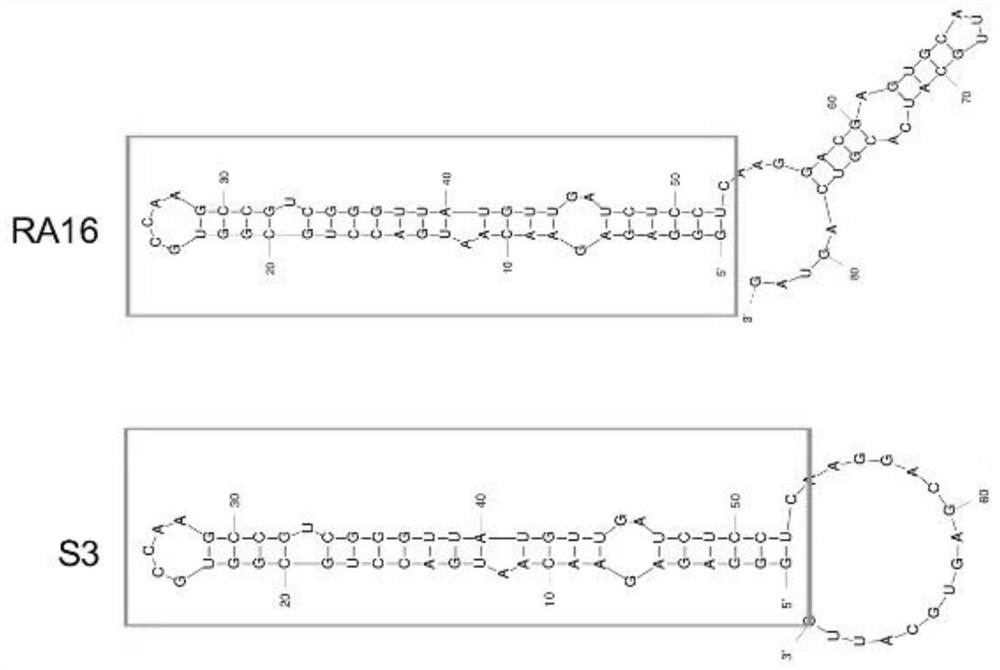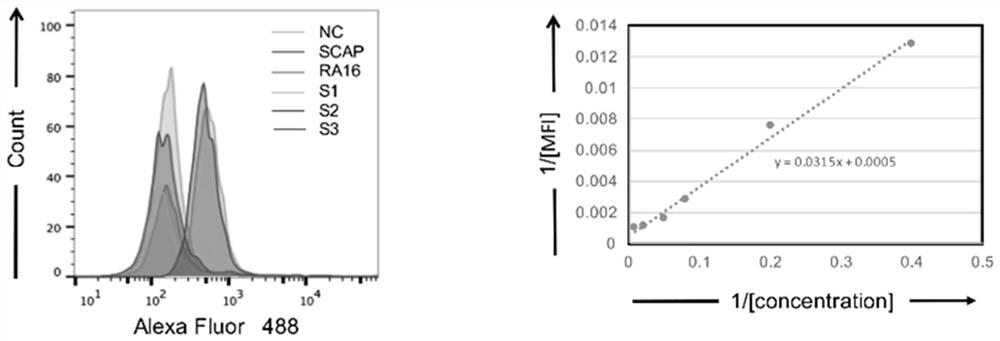Human non-small cell lung cancer nucleic acid aptamer truncation body and application thereof
A non-small cell lung cancer, nucleic acid aptamer technology, applied in the field of biomedicine, can solve the problems of long length, small molecular weight, unsuitable for large-scale in vitro synthesis and modification, etc. The effect of easy large-scale chemical synthesis
- Summary
- Abstract
- Description
- Claims
- Application Information
AI Technical Summary
Problems solved by technology
Method used
Image
Examples
Embodiment 1
[0023] Example 1 Amplification of nucleic acid aptamer truncations in human non-small cell lung cancer.
[0024] SEQ NO.1 sequence:
[0025] GGGAGAGAACAAUGACCUGCGGUGCCAAGCCGUCGGGUUAUGUUGAUCUCCUCAAGGACGAGUGCAUUG
[0026] The sequence can be obtained by in vitro synthesis or in vitro transcription, wherein the steps of in vitro transcription are as follows:
[0027] DNA template:
[0028] CACTAATACGACTCACTATAGGGAGAGAACAATGACCTGCGGTGCCAAGCCGTCGGGTTATGTTGATCTCCACAAGGACGAGTGCATTG.
[0029] Using the above DNA as a template and 2'F-dCTP, 2'F-dUTP, CTP, ATP, amino-GMP as substrates, the in vitro transcription reaction was carried out. The reaction conditions are: 37°C, 8h. After the reaction was completed, the DNA template was removed with DNase I, and the purified RNA aptamer truncated body was obtained by phenol / chloroform extraction and ethanol precipitation, which was named truncated body S3.
[0030] 5' PEG and NH on truncation S3 2 Modification:
[0031] 5' PEG modificat...
Embodiment 2
[0034] Example 2 The binding effect of the nucleic acid aptamer truncation in human non-small cell lung cancer.
[0035] Fluorescently label the truncated body S3 of the nucleic acid aptamer: aminally-dUTP is incorporated during transcription, the molar ratio of aminally-dUTP to 2'F-dUTP is 1:5, and NHS-labeled fluorescent dye (material Alexa Fluor 488) in 0.1M NaHCO 3 React in the buffer solution for 2 hours at room temperature, and remove unreacted fluorescent dye by ultrafiltration through a YM-10 column.
[0036] The binding effect of the nucleic acid aptamer of the present invention to human non-small cell lung cancer NCI-H460 cells (purchased from ATCC) was detected by fluorescence microscopy. Human non-small cell lung cancer NCI-H460 cells were cultured in a 24-well plate, the medium was poured out, and the H460 cells were washed three times with PBS, and then mixed with 200 nM RA16 and the nucleic acid aptamer truncation S3 bindingbuffer (0.2mM Tris(pH7.5), 0.5M NaCl...
Embodiment 3
[0037] Example 3 Binding specificity of nucleic acid aptamer truncations for human non-small cell lung cancer.
[0038] The specificity of the nucleic acid aptamer truncation of the present invention binding to human non-small cell lung cancer NCI-H460 cells was detected by flow cytometry. Experiments have proved that the truncated form S3 of RA16 can also specifically recognize and inhibit human non-small cell lung cancer cell lines, such as image 3 As shown, the truncated form S3 of RA16 still has specific binding ability to human non-small cell lung cancer H460 cell line. At the same time, we calculated by flow cytometry that the Kd value of truncated body S3 for human non-small cell lung cancer H460 is about 63.20±0.91nM.
PUM
 Login to View More
Login to View More Abstract
Description
Claims
Application Information
 Login to View More
Login to View More - R&D Engineer
- R&D Manager
- IP Professional
- Industry Leading Data Capabilities
- Powerful AI technology
- Patent DNA Extraction
Browse by: Latest US Patents, China's latest patents, Technical Efficacy Thesaurus, Application Domain, Technology Topic, Popular Technical Reports.
© 2024 PatSnap. All rights reserved.Legal|Privacy policy|Modern Slavery Act Transparency Statement|Sitemap|About US| Contact US: help@patsnap.com










